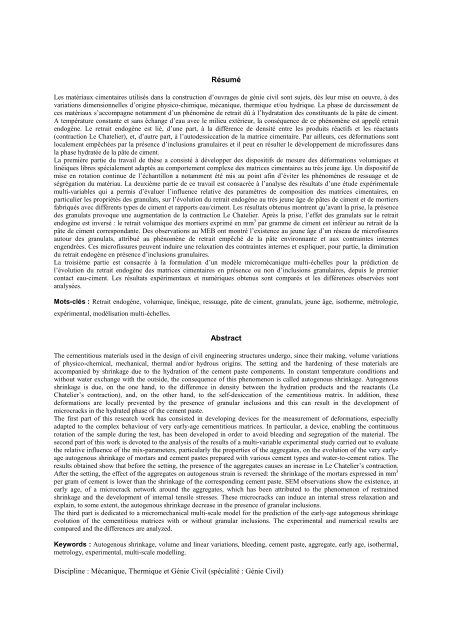Téléchargement - Ecole Française du Béton
Téléchargement - Ecole Française du Béton
Téléchargement - Ecole Française du Béton
You also want an ePaper? Increase the reach of your titles
YUMPU automatically turns print PDFs into web optimized ePapers that Google loves.
Résumé<br />
Les matériaux cimentaires utilisés dans la construction d’ouvrages de génie civil sont sujets, dès leur mise en oeuvre, à des<br />
variations dimensionnelles d’origine physico-chimique, mécanique, thermique et/ou hydrique. La phase de <strong>du</strong>rcissement de<br />
ces matériaux s’accompagne notamment d’un phénomène de retrait dû à l’hydratation des constituants de la pâte de ciment.<br />
A température constante et sans échange d’eau avec le milieu extérieur, la conséquence de ce phénomène est appelé retrait<br />
endogène. Le retrait endogène est lié, d’une part, à la différence de densité entre les pro<strong>du</strong>its réactifs et les réactants<br />
(contraction Le Chatelier), et, d’autre part, à l’autodessiccation de la matrice cimentaire. Par ailleurs, ces déformations sont<br />
localement empêchées par la présence d’inclusions granulaires et il peut en résulter le développement de microfissures dans<br />
la phase hydratée de la pâte de ciment.<br />
La première partie <strong>du</strong> travail de thèse a consisté à développer des dispositifs de mesure des déformations volumiques et<br />
linéiques libres spécialement adaptés au comportement complexe des matrices cimentaires au très jeune âge. Un dispositif de<br />
mise en rotation continue de l’échantillon a notamment été mis au point afin d’éviter les phénomènes de ressuage et de<br />
ségrégation <strong>du</strong> matériau. La deuxième partie de ce travail est consacrée à l’analyse des résultats d’une étude expérimentale<br />
multi-variables qui a permis d’évaluer l’influence relative des paramètres de composition des matrices cimentaires, en<br />
particulier les propriétés des granulats, sur l’évolution <strong>du</strong> retrait endogène au très jeune âge de pâtes de ciment et de mortiers<br />
fabriqués avec différents types de ciment et rapports eau/ciment. Les résultats obtenus montrent qu’avant la prise, la présence<br />
des granulats provoque une augmentation de la contraction Le Chatelier. Après la prise, l’effet des granulats sur le retrait<br />
endogène est inversé : le retrait volumique des mortiers exprimé en mm 3 par gramme de ciment est inférieur au retrait de la<br />
pâte de ciment correspondante. Des observations au MEB ont montré l’existence au jeune âge d’un réseau de microfissures<br />
autour des granulats, attribué au phénomène de retrait empêché de la pâte environnante et aux contraintes internes<br />
engendrées. Ces microfissures peuvent in<strong>du</strong>ire une relaxation des contraintes internes et expliquer, pour partie, la diminution<br />
<strong>du</strong> retrait endogène en présence d’inclusions granulaires.<br />
La troisième partie est consacrée à la formulation d’un modèle micromécanique multi-échelles pour la prédiction de<br />
l’évolution <strong>du</strong> retrait endogène des matrices cimentaires en présence ou non d’inclusions granulaires, depuis le premier<br />
contact eau-ciment. Les résultats expérimentaux et numériques obtenus sont comparés et les différences observées sont<br />
analysées.<br />
Mots-clés : Retrait endogène, volumique, linéique, ressuage, pâte de ciment, granulats, jeune âge, isotherme, métrologie,<br />
expérimental, modélisation multi-échelles.<br />
Abstract<br />
The cementitious materials used in the design of civil engineering structures undergo, since their making, volume variations<br />
of physico-chemical, mechanical, thermal and/or hydrous origins. The setting and the hardening of these materials are<br />
accompanied by shrinkage <strong>du</strong>e to the hydration of the cement paste components. In constant temperature conditions and<br />
without water exchange with the outside, the consequence of this phenomenon is called autogenous shrinkage. Autogenous<br />
shrinkage is <strong>du</strong>e, on the one hand, to the difference in density between the hydration pro<strong>du</strong>cts and the reactants (Le<br />
Chatelier’s contraction), and, on the other hand, to the self-desiccation of the cementitious matrix. In addition, these<br />
deformations are locally prevented by the presence of granular inclusions and this can result in the development of<br />
microcracks in the hydrated phase of the cement paste.<br />
The first part of this research work has consisted in developing devices for the measurement of deformations, especially<br />
adapted to the complex behaviour of very early-age cementitious matrices. In particular, a device, enabling the continuous<br />
rotation of the sample <strong>du</strong>ring the test, has been developed in order to avoid bleeding and segregation of the material. The<br />
second part of this work is devoted to the analysis of the results of a multi-variable experimental study carried out to evaluate<br />
the relative influence of the mix-parameters, particularly the properties of the aggregates, on the evolution of the very earlyage<br />
autogenous shrinkage of mortars and cement pastes prepared with various cement types and water-to-cement ratios. The<br />
results obtained show that before the setting, the presence of the aggregates causes an increase in Le Chatelier’s contraction.<br />
After the setting, the effect of the aggregates on autogenous strain is reversed: the shrinkage of the mortars expressed in mm 3<br />
per gram of cement is lower than the shrinkage of the corresponding cement paste. SEM observations show the existence, at<br />
early age, of a microcrack network around the aggregates, which has been attributed to the phenomenon of restrained<br />
shrinkage and the development of internal tensile stresses. These microcracks can in<strong>du</strong>ce an internal stress relaxation and<br />
explain, to some extent, the autogenous shrinkage decrease in the presence of granular inclusions.<br />
The third part is dedicated to a micromechanical multi-scale model for the prediction of the early-age autogenous shrinkage<br />
evolution of the cementitious matrices with or without granular inclusions. The experimental and numerical results are<br />
compared and the differences are analyzed.<br />
Keywords : Autogenous shrinkage, volume and linear variations, bleeding, cement paste, aggregate, early age, isothermal,<br />
metrology, experimental, multi-scale modelling.<br />
Discipline : Mécanique, Thermique et Génie Civil (spécialité : Génie Civil)


